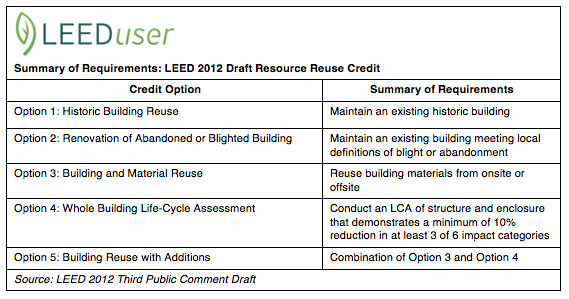Key changes in the the IEQ section of LEED-NC (part of LEED BD&C) in the third public comment draft of LEED 2012 are discussed below. Do you have comments or questions on this draft? Discuss them below with your fellow LEED professionals. Substantive comments submitted here during USGBC's third public comment period here will be submitted to USGBC and considered "official" public comments.
More information on LEED 2012 certification and the third public comment.
Minimum IAQ Performance, a prerequisite still references minimum ASHRAE-62.1–2010 requirements. In a change, outdoor air delivery monitoring requirements that had been folded into a consolidated credit are included as a prerequisite for all BD&C projects, not just CS.
Environmental Tobacco Smoke Control sees additional fine-tuning of requirements rather than any major change (such as absolute prevention of smoking). Non-smoking requirements extend to outdoor spaces used for business purposes, like patio seating.
The new Enhanced Indoor Air Quality Strategies credit retains its repackaging of key requirements from eliminated credits—Outdoor Air Delivery Monitoring, Increased Ventilation, and Indoor Chemical and Pollutant Source Control. With some minor language tweaks in this round, including adjustments for international projects, Option 1 in this new credit includes the key track-off, exhaust, and filtering requirements from LEED 2009’s IEQc5, and includes the key natural ventilation requirements that are part of IEQc2: Increased Ventilation in LEED 2009. Option 2 for this credit requires meeting Option 1, plus requirements that are similar to LEED 2009 requirements for increased ventilation over ASHRAE 62.1 and for outdoor air delivery monitoring. Those requirements are a bit more sophisticated, however, incorporating use of modeling (with new details in this draft such as specific mention of Computational Fluid Dynamics) to show that air contaminants will be below key exposure levels.
The third draft of LEED 2012 brings us a third major overhaul of Low-Emitting Interiors, although the overall systems approach introduced in the first draft remains. The system has changed, and now references seven relevant systems: paints and coatings; adhesives and sealants; flooring; composite wood; ceilings, walls, thermal and acoustic insulation; furniture (if in scope); and exterior-applied products, which is only relevant in Healthcare and Schools. In a change that is more like the first 2012 draft and LEED 2009, projects will now have to earn points by being compliant in one or more of these systems. A more sophisticated total percentage compliant score, more akin to the second draft, is available for projects that want to use a budget method. There are more specific requirements regarding manufacturers’ claims and standards for testing laboratories. As with the previous draft, product compliance is based on exposure limits defined in California Department of Public Health (CDPH) Standard Method V1.1-2010, often referred to as California Section 01350.
Construction IAQ Management Plan is back as a credit, not a prerequisite. It is unchanged from the last draft except for a European-friendly filtration reference, and what amounts to an enhanced environmental tobacco smoke credit for construction: “Prohibit the use of tobacco products inside the building and within 50 feet (15 meters) (or greater, if local jurisdiction requires) of the building entrance during construction.”
Indoor Air Quality Assessment is the new name for Construction IAQ Management Plan—Before Occupancy, and it hasn’t changed a lot sine the previous draft, in which the Option 1 flush-out path preferred by most LEED projects would be downgrade to one point, versus two points for Option 2: Air Testing. Changes in this draft appear to be minor and involve specifying ASTM and EPA test methods for various contaminants. Carbon monoxide has been added as a chemical to be tested.
The Thermal Comfort credit, which folds in the old design and control credits that were separate, has been updated with some wording changes and a new reference to ISO 7730, a more international-friendly standard.
The new Interior Lighting credit covers the scope of the LEED 2009 “Controllability of Lighting” credit, which falls under Option 1, while Lighting Quality can optionally be pursued for a separate point under Option 2. The changes in this draft are mostly minor, retaining specific emphasis on providing three lighting levels (or “scenes”) for individual and multi-occupant spaces: on, off, and mid-level. For lighting quality, projects would have a choice of meeting four quality measures, which are now in two categories: hardware and design. These measures include color rendering index (CRI) requirements and use of bright surfaces.
The Daylight credit, overhauled in the first draft of LEED 2012, is overhauled again here. The focus of the first of two simulation options is providing a new metric, Spatial Daylight Autonomy, defined as “the percent of aggregate floor area of regularly occupied spaces which achieves a minimum hourly illuminance value of 300 lux at task level for at least 50% of the hours between 8 a.m. and 6 p.m., local clock time, after accounting for typical weather conditions, exterior obstructions, attached furniture systems, and after blinds have been operated hourly to block direct sun predicted to enter the space that would fall on more than 2% of the calculation grid.” The second simulation option is not changed as significantly, whiel the third option, for measurement, has gained specifics on how measurement should be performed, such as measuring twice, at diverse times of year. The first simulation option provides the most points in this draft, up to three, the second option offers up to two, while measurement provides only one.
The LEED 2009 credit on views became Quality Views in the first LEED 2012 draft, and thus it remains. The credit has wording changes in this draft, but nothing that appears significant. Occupants should be able to discern objects at least 25 feet outside the vision glazing; flora, fauna, or sky; and movement for quality views.
An Acoustic Performance credit was previously only available to Schools projects remains available to NC projects in this draft. Pprojects would have to achieve four specific acoustical objectives defined in the credit language, although one of these has been removed from the last draft: requirements for speech privacy. Vague language allowing historic renovation projects to justify design decisions outside of the credit requirements has been made more specific: three of four requirements must still be met, with a narrative explaining design decisions.
What's your take on the proposed changes? Please post your public comments below.




Add new comment
To post a comment, you need to register for a LEEDuser Basic membership (free) or login to your existing profile.